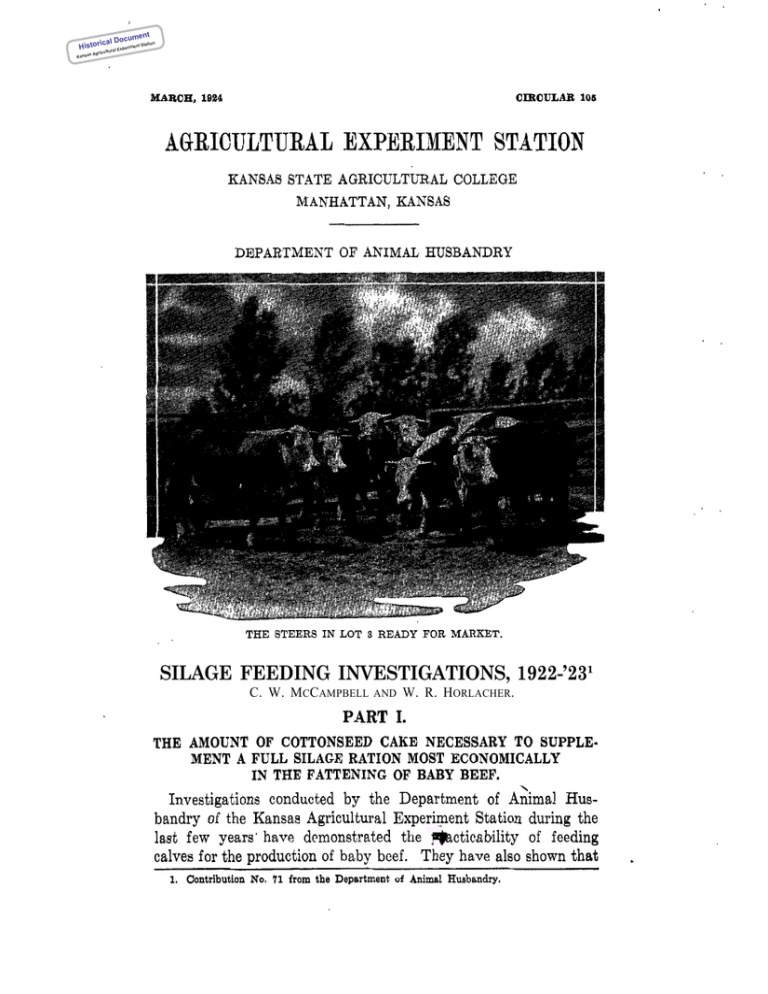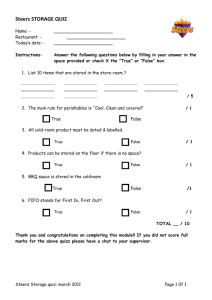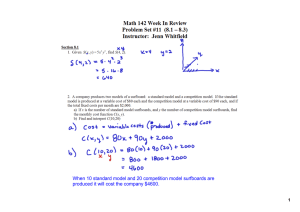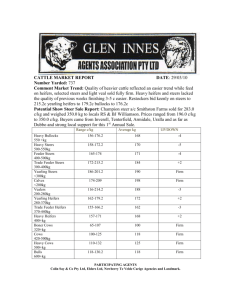SILAGE FEEDING INVESTIGATIONS, 1922-’23¹ C. W. M C
advertisement

t cumen n cal Do tio Histori ural Experiment Sta Kansas Agricult SILAGE FEEDING INVESTIGATIONS, 1922-’23¹ C. W. MCCAMPBELL AND W. R. HORLACHER. t cumen n cal Do tio Histori ural Experiment Sta ult Agric Kansas the cost of producing baby beef can be lowered materially by the use of silage in the ration. Steers consuming a large amount of silage, which is a carbonaceous roughage, will not eat in addition a very large amount of a nitrogenous roughage. Since corn, or any of the other grains which are sometimes substituted for it in the fattening ration, is a carbonaceous concentrate, the ration produced by the use of all the silage and shelled corn steers will eat, supplemented with what alfalfa hay they will consume in addition, is rather low in nitrogenous constituents. To increase the proportion of these in the ration it is necessary to add a nitrogenous concentrate such as cottonseed cake. Since this forms a very expensive constituent, the feeder should not feed it in large amounts unless by so doing he can increase either the rate of gain, the finish, or both the gain and the finish enough to repay for the extra feed consumed. A feeding experiment was conducted during the winter of 1922-’23 to determine the amount of cottonseed cake that the feeder can most economically add to a ration of shelled corn, cane silage, and alfalfa hay used in the fattening of baby beef. I n connection with this experiment a group of heifers was fed to secure additional data regarding the production of baby beef from heifers. FEEDING PLAN. The calves used in this experiment were high-grade Herefords. They were raised a t the Fort Hays branch of the Kansas Agricultural Experiment Station and were shipped to Manhattan, October 22, 1922. During the time which elapsed between this and November 3, when the experiment was started, the calves were fed on cane silage and alfalfa hay. The 50 steers were divided as carefully a s possible with regard to size, type and quality into five lots. Ten heifers similar to the steers in size, type and quality were placed in the sixth lot: Each group was kept in a lot approximately 30 by 40 feet, including a shed 15 feet deep and open on the south, located across the north end of the lot. They had access to salt and water a t all times. The length of the feeding period was 231 days. Each lot was fed exactly the same basal ration of shelled corn and cane silage, both full fed, and two pounds of alfalfa hay per t cumen n cal Do tio Histori ural Experiment Sta Kansas Agricult head per day. In addition to this the different lots were fed cottonseed cake in the following amounts per head per day: t cumen on cal Do Histori ural Experiment Stati Kansas Agricult 1. The steers in lot 2 receiving one-halt pound of cottonseed cake per head per day made 0.14 of a pound greater gain per head per day than did the steers in lot 1 receiving no cottonseed cake. The one-half pound of cottonseed cake per head per day added enough finish to increase the selling price 10 cents per hundred and the profit 69 cents per head. 2. The steers in lot 3 receiving one pound of cottonseed cake per head per day made 0.22 of a pound greater gains per head per day than did the steers in lot 1 receiving no cottonseed cake and 0.08 of a pound greater gains per head per day than the steers in lot 2 receiving one-half pound of cottonseed cake per head per day. The one pound of cottonseed cake per head per day added enough finish to the steers in lot 3 to increase their selling price 45 cents per hundred over the selling price of the steers in lot 1 receiving no cottonseed cake and increased the profit $2.07 per head. The addition of one pound of cottonseed cake per head per day also added enough finish to the steers in lot 3 to increase their selling price 35 cents per hundred over the selling price of the steers in lot 2 receiving one-half pound of cottonseed cake per head per day and increased the profits $1.38 per head. 3. The addition of one and one-half pounds of cottonseed cake per head per day in lot 4 and two pounds per head per day in lot 5 increased both gains and selling price so slightly over the gains and selling price of lot 3 that the profits in both lots were less than the profits in lot 3 receiving one pound of cottonseed cake per head per day. 4. The profits in lot 4 receiving one and one-half pounds of cottonseed cake per head per day were 48 cents per head less than in lot 1 receiving no cottonseed cake; $1.17 less per head than in lot 2 receiving one-half pound per head per day; $2.55 per head less than in lot 3 receiving one pound per head per day; and 34 cents per head greater than in lot 5 receiving two pounds of cottonseed cake per head per day. The profits in lot 5 receiving two pounds of cottonseed cake per head per day were 82 cents per head less than in lot 1 receiving no cottonseed cake; $1.51 per head less than in lot 2 receiving one-half pound of cottonseed cake per head per day; $2.89 per head less than in lot 3 receiving one pound of cottonseed cake per head per day; and 34 cents per head less than in lot 4 receiving one and one-half pounds of cottonseed cake per head per day. t cumen n cal Do tio Histori ural Experiment Sta ult Agric Kansas 5. The heifers fattened more rapidly than the steers fed the same ration and were fatter a t the close of the experiment, but their total gains were not quite as great. In spite of the fact that the heifers were a bit fatter, dressed as well, and looked as good on the hooks, they sold on the market for $1.50 less per hundred pounds than did the steers. Due to these differences the steers returned a profit of $14.57 per head more than the heifers. t cumen on cal Do Histori ural Experiment Stati Kansas Agricult 1. These results indicate the value of adding up to one pound of cottonseed cake per head per day t o a ration consisting of corn, silage, and alfalfa hay when fed in fattening baby beef; also the impracticability of adding more than one pound per head per day when feed values and cattle prices maintain approximately the same ratios as prevailed during this experiment. 2. It is not always the cattle that make the most rapid gains nor the cattle whose ration is the least costly that make the most profit. It is important to know how to combine feeds in such a manner that they will produce the most rapid gains and the highest degree of finish a t the least possible cost. 3. Cottonseed cake acts as a stimulant to the appetite of cattle. 4. A very decided discrimination against heifer beef exists on the market a t the present time. 5. As long as the packer insists upon paying less for heifers than steers the feeder must also pay less for heifer calves than for steer calves for feeding purposes. 6. Heifer calves will gain almost as rapidly as steer calves in the feed lot and will be fatter a t the end of any given feeding period. The influence of feeding different amounts of cottonseed cake, under the conditions of this experiment, is shown graphically in figure 1. THE INFLUENCE OF WINTER RATIONS UPON SUMMER GAINS ON PASTURE ALONE. The opinion has been expressed often that cattle wintered on silage would not do well on grass the following season. In the fall of 1919 a test was begun by the Kansas Agricultural Experiment Station for the purpose of securing data relative to this matter. A group of steers calved during the spring of 1919 purchased from Alex Philip, of Hays, Kan., was used. They were divided into two lots. One lot was fed silage and approximately one pound of cottonseed cake per head per day during the winter months. The other lot received alfalfa hay only. Both lots were pastured together on bluestem grass during the summer. The test continued through three winters and three summers. Results in detail are given in Table II. t cumen n cal Do tio Histori ural Experiment Sta ult Agric Kansas 1. During the first winter the silage-fed steers gained 26.66 pounds per head more than the alfalfa-hay-fed steers, but they gained 14.2 pounds less while on grass during the following summer. The silage-fed steers, however, made a gain of 12.46 pounds more per head than the alfalfa-hay-fed steers for the combined winter and summer period of the first year. 2. During the second winter the silage-fed steers were fed liberally on silage and made a gain of 79.07 pounds per head more than the alfalfa-hay-fed steers, but they gained 101.61 pounds less on grass during the following summer. The silage-fed steers made a t cumen n cal Do tio Histori ural Experiment Sta Kansas Agricult gain of 22.54 pounds per head less than the alfalfa-hay-fed steers for the combined winter and summer period of the second year. 3. During the third winter the silage-fed steers were fed only a limited amount of silage, just enough to keep their total winter gains less than those fed alfalfa, and they made 26.59 pounds per head less than the alfalfa-fed steers, but 13.33 pounds more while on grass the following summer, or 13.26 pounds less for the combined winter and summer period of the third year. 4. The steers fed silage during the winter months made a total gain during the three years of 255 pounds per head, while the steers fed alfalfa gained only 175.86 pounds per head during the same period. 5. The steers fed silage during the winter months made a total pasture gain during the three year of 674.19 pounds per head and the steers fed alfalfa during the winter months, 776.28 pounds. 6. The steers fed silage during the winter months made a total summer and winter gain during the three years of 929.19 pounds per head, an average of 309.73 pounds per year from the time they were weaned. The steers fed alfalfa hay during the winter months made a total three-year gain of 952.53 pounds per head, or an average of 317.51 pounds per year from the time they were weaned. 7. These cattle were marketed in Kansas City, September 30, 1922. They brought $9 a hundred, the top price for the year for grass-fat cattle that had never eaten grain. CONCLUSIONS. 1. Silage and one pound of cottonseed cake per head per day is a satisfactory winter ration for stock cattle. Alfalfa hay alone is also a satisfactory winter ration for stock cattle. The choice of the two, will depend upon their availability and cost in a given locality. 2. The amount of gain a steer makes on pasture during the summer depends upon the amount of fat he carries when he goes to grass rather than upon the kind of feed he consumed during the preceding winter months. 3. Thin steers make nearly as much gain on bluestem pasture during the months of May and June as they do during the remainder of the grazing season. t cumen on cal Do Histori ural Experiment Stati Agric Kansas ult PART III. FINISHING GRASS-FAT CATTLE ON GRAIN. Another group of steers of the same age, breeding, and quality were handled in exactly the same manner up to September 4, 1922, as those discussed in Part II. On that date they were started on ground corn. The behavior of this group of steers up to September 4, 1922, was practically identical with those discussed in Part II as is shown in Table III. t cumen n cal Do tio Histori ural Experiment Sta Agric Kansas ult These steers were gotten up to a full feed of corn as rapidly as possible and were left on the grass for 60 days, receiving only bluestem grass and corn from September 4 to November 4, 1922. On this date they were moved to a dry lot and fed silage and alfalfa hay in addition to the ground corn for 23 days. Detailed results are shown in Table IV. 1. The gains made based upon selling weights were very small, being only 0.78 of a pound per day. This is partly due to the fact that these cattle received a very poor ship and did not arrive a t the market until 10:30 a. m. They then refused to eat or drink, and this resulted in a shrink of 57.5 pounds per head on a 120-mile ship. 2. These cattle, valued a t $9 per hundred a t the beginning of the test, sold for $11 per hundred a t the end of the 83-day feeding period. 3. The additional finish made during this 83-day feeding on corn was sufficient to increase the value of these cattle a t least $2 per hundred, and in spite of a very high cost of gains ($21.78 per hundred), and a very poor ship, they made a net return of $14.16 per head more than the same kind of cattle marketed off grass without a grain finish.



